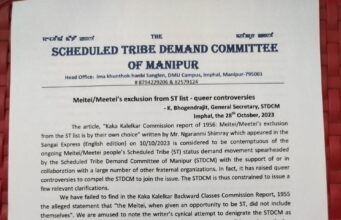 The Aimol tribe is one of the 33 scheduled tribes of Manipur. They are found in three hill districts of the state, namely Chandel, Churachandpur and Senapati.
The Aimol tribe is one of the 33 scheduled tribes of Manipur. They are found in three hill districts of the state, namely Chandel, Churachandpur and Senapati.
According to the Census of 2001, the population of Aimol tribe is 3643 as compared to the population of 1862 at the Census of 1981.
- The Aimol tribes are mainly concentrated in Chandel district. They are found in the foothill areas of Senapati-Chandel interstate bordering areas. The Aimol villages in Chandel district are (1) Unapal (2) Satu (3) Kumirei (4) Chingnunghut (5) Aimol Tampak (6) Khodomphai Ngairong Aimol (7) Chandonpokpi and (8) Soibong (Khudengthabi). In Churachandpur district, they are found in Kha-Aimol and Luichungbum, and in Senapati district they are found in Tuikhong village.
- The Aimol tribe has been classified under the Kuki-Chin-Mizo (Lushai) group by many writers and linguistically they are also classified as one of the member of Old Kuki branch of Kuki section, Burmic Division of Sino-Tibetan language. However, the Aimols prefer to live independently of any affiliation and prefer to maintain a distinctive identity of their own. The Aimol Tribe Union was formed in 1991 to promote solidarity and safeguard their identity.
- Etymologically the name Aimol corresponds to a past habit of the people and the word is derived from the roots “ai”, a small plant like ginger which is grown abundantly on the spur hill “mol”. Shakespeare in Lushai Kuki Clans; 1912, 149, marked the appearance of the Aimol in Manipur in 1723.
- The Aimol tribe has been divided into five clans with sub-clans, namely Chongnom (with three sub-clans), Laita (three sub-clans), Lanu (four sub-clans), Chaithu (no sub-clan) and Chongthu (two sub-clans). The Aimol clans possess totems of their own which is associated to their ancestor. They are regarded and prayed as the gods of the clans.
- The indigenous mode of political organization of a village centres around the council known as Pasakaret subordinated by another association. Parakaret consists of eight councillors of which the head is Tamasakoi. The subordinate council i.e Thoukanai also consists of the same number of post. Except the Tamsakoi as the hereditary post, for others, post recruitment is on the line of promotion. Tamsakoi remains exclusive right for the eldest Chongnom clan members.
- The Aimols of present generation are Christian by religion. It was introduced to them some 27 years ago. Prior to this new religion, they were animistic and believed in many deities and spirits. They believed in the existence of village deity (Kho-Pathian) and house deity (In-Pathian). They worshipped Sailing and Bongjei, protector of village; Chahou, Pathian of agriculture and paddy; Niso, for prosperity and peace; Arkun Pathian, goddess of human fertility worshipped particularly by pregnant women.
- These are propitiated so that they may not do any harm to the people. To ward off disease and cure illness, Ramdoi and Song Kot are worshipped with rite. Likewise, success or failure in war and hunting was ascribed to the action of Chuwan Pathian.
- The main occupation of the Aimol tribe is agriculture and allied activities including domestication of cattle, pig and fowl. Weaving and livestock rearing generate good income to the family.
- Shekili, Uike Chu, Laijiak, Puanthal, Shorte, Panchai, Shuihboh, Puante and Puandum are names of some of the traditional men’s dress and ornaments while Khamtang, Kuwapaam, Shenchial, Aitang, Reinuam, Khongkhimor and Saikhup are the names of women’s dress.











